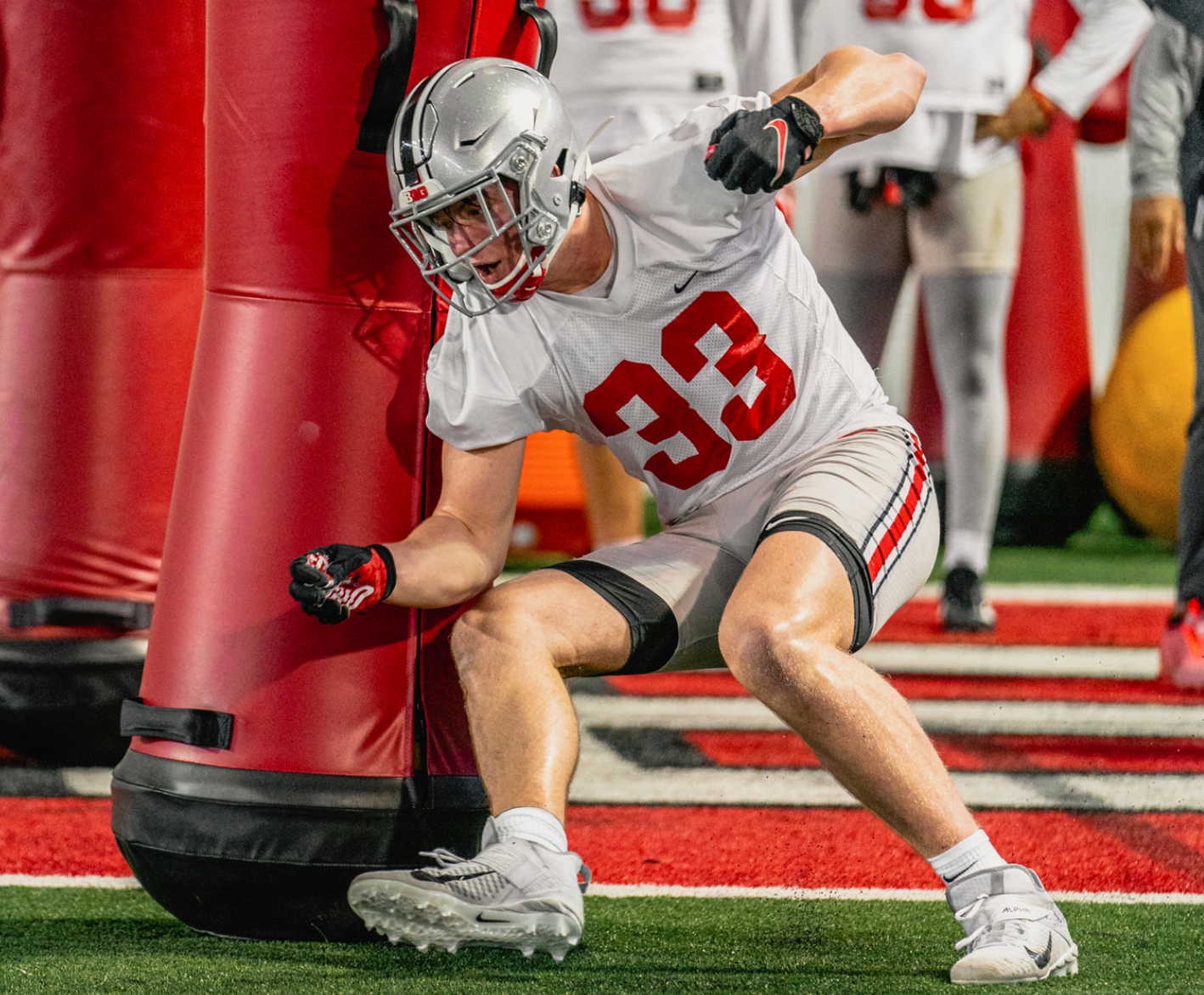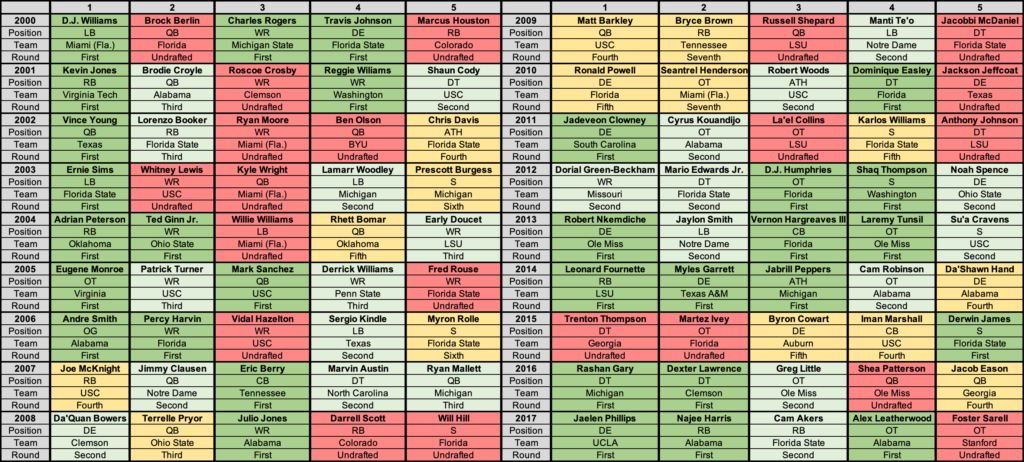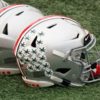
Ohio State has consistently been one of the top recruiters in the country since Urban Meyer took over as head coach in 2012, and that has continued into the Ryan Day era.
That was evident in the 2021 class that finished as the No. 2 overall class in the nation behind only Alabama. Ohio State’s 2021 class was given a late boost by Sammamish (Wash.) Eastside Catholic five-star defensive lineman J.T. Tuimoloau, who made his decision to commit to the Buckeyes on July 4.
His commitment gives Ohio State two commits that rank in the top five for the 2021 class, with Tuimoloau ranking third and fellow defensive lineman Jack Sawyer coming in at fourth in the 247Sports composite rankings.
But, how often do players in the top five of the composite rankings live up to all that hype?
The 247Sports composite goes back to 2000, and one of the better gauges of if players were as good as promised is by where they ended up in the NFL draft, whenever it was that they ultimately decided to leave the program. While this, of course, is not an exact science, as some players light it up in college but aren’t as built for the pros, it felt as close as possible to a measurement.
Looking at sample size, the field of top five players for this looks at the classes from 2000 to 2017. The start date is because, as previously mentioned, that is when the composite rankings began. The 2017 class is the end date because it is the most recent class to have all of its top five declare for the draft.
That leaves 90 players in the group, each of which were considered players with the highest potential in the country. This is where they each landed, or didn’t land, in various NFL drafts. The dark green signifies a first round pick, light green signifies a Day Two (second or third round) selection, yellow is a Day Three (rounds 4-7) selection and red is for players that went undrafted.
The team listed for the recruits is what they initially signed on as for the class, despite some of the players ultimately transferring or leaving the team for a variety of reasons.

In total, 31 of the 90 top five prospects over the first 18 years of the composite rankings went in the first round. That is just 34.4 percent, though it was the most likely of the four outcomes. Going deeper than just the top five, 12 of the 18 No. 1 overall prospects in a class – 66.7 percent – lived up to the hype enough to get taken within the first 32 picks.
It was also extremely rare for the composite rankings to completely swing and miss on first-round talents. Just one of the 18 years – 2009 – had no players taken in the first round. But even that year likely should have had one, with linebacker Manti Te’o finishing second in the Heisman Trophy voting. His draft stock fell due to a poor performance at the NFL Combine, as well as some other well-documented events that happened outside of football.
Te’o was one of 23 players to go in the second or third rounds in the draft, good for 25.6 percent of the sample. Fifteen of the 90, or 16.7 percent, went on Day Three, while 21 players, or 23.3 percent, did not get drafted. That percentage may continue to go down, as just four top-five players in classes from 2012-17 went undrafted, just 13.3 percent.
Going position by position, the most likely group to get selected in the first round by success rate were the offensive linemen. Of the 11 tackles and one guard, five went in the first: Eugene Monroe, Andre Smith, D.J. Humphries, Laremy Tunsil and Alex Leatherwood. Being the only guard, Smith gives the specific position a 100 percent first round rate.
Following closely behind the offensive linemen are the defensive backs and defensive linemen, the latter of which is good news for Ohio State with Sawyer and Tuimoloau entering the fray. Each position had 40 percent of their group land in the first round.
Looking at the secondary, two out of the three cornerbacks in the sample made the cut, as did a pair of the seven safeties. Not only did defensive linemen dominate the total amount of top five players with 20, they also had the most first-round picks with eight. They have also have picked up more steam as late, with the three D-linemen from the 2016 and 2017 classes all going in the first.
The least successful position at getting drafted early, by a sizable margin, were the quarterbacks. Of the 14 signal-callers ranked in the top five, only two – Vince Young and Mark Sanchez – got selected on Day One, just 14.3 percent. Even further, over a third of the quarterbacks – 5 of 14 (35.7 percent) – went undrafted.
This number would be improved dramatically with the inclusion of the 2018 class that included Trevor Lawrence and Justin Fields, who both were taken in the first round at No. 1 and 11, respectively. Ohio State fans can only hope that 2022 commit Quinn Ewers, the No. 1 overall prospect in the class, continues putting the quarterback position on the right track toward the top.
Ohio State has just two top five prospects through these 18 classes and is sitting at a 50 percent success rate. Wide receiver Ted Ginn Jr. was selected ninth overall, and while quarterback Terrelle Pryor did not get taken in the regular 2011 NFL Draft, it was because of the results from Tattoogate. He was ultimately taken in the third round of that year’s supplemental draft by the Oakland Raiders, meaning that the Raiders lost, at the time, next year’s third round pick to take him.
With Sawyer, Tuimoloau, Ewers and 2020’s No. 3 overall prospect, wide receiver Julian Fleming, on deck for Ohio State, the Buckeyes will have plenty of opportunities to get over that 50 percent threshold. But, if the first 18 classes of the 247Sports composite era have proven anything, not even the very best prospects can be a sure thing.








